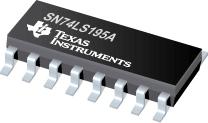These 4-bit registers feature parallel inputs, parallel outputs, J-K\ serial inputs, shift/load (SH/LD\\) control input, and a direct overriding clear. All inputs are buffered to lower the input drive requirements. The register has two modes of operation:
●Parallel (broadside) loadShift (in the direction QA toward QD)
●Parallel loading is accomplished by applying the four bits of data and taking SH/LD\ low. The data is loaded into the associated flip-flop and appears at the outputs after the positive transition of the clock input. During loading, serial data flow is inhibited.
●Shifting is accomplished synchronously when SH/LD\ is high. Serial data for this mode is entered at the J-K\ inputs. These inputs permit the first stage to perform as a J-K\, D-, or T-type flip-flop as shown in the function table.
●The high-performance "S195, with a 105-megahertz typical maximum shift-frequency, is particularly attractive for very-high-speed data processing systems. In most cases existing systems can be upgraded merely by using this Schottky-clamped shift register.
● Synchronous Parallel Load
● Positive-Edge-Triggered Clocking
● Parallel Inputs and Outputs from Each Flip-Flop
● Direct Overriding Clear
● J and K\ Inputs to First Stage
● Complementary Outputs from Last Stage
● For Use in High Performance:
● Accumulators/Processors
● Serial-to-Parallel, Parallel-to-Serial Converters


